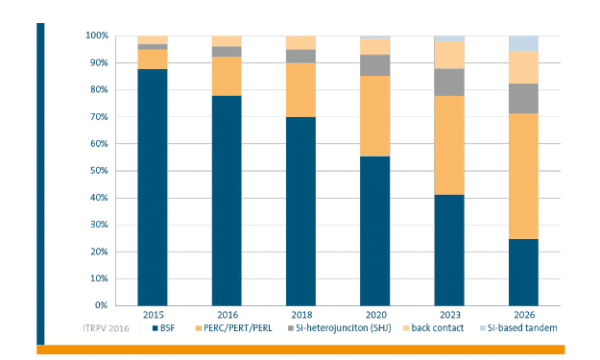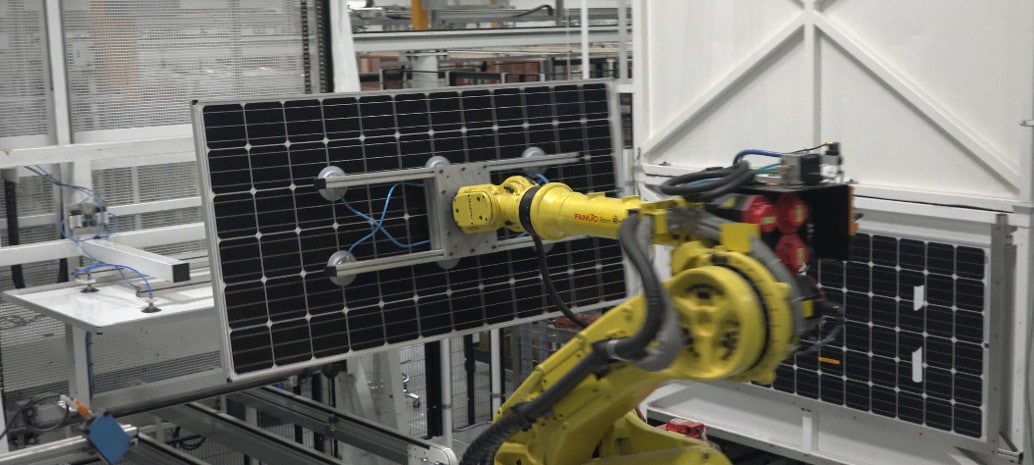For the last seven years, the International Technology Roadmap for Photovoltaics (ITRPV) has served as the definitive document to forecast near-term future technology development in the solar PV industry.
This seventh edition of the ITRPV is the second time that German engineering federation VDMA has produced the report without the collaboration of SEMI, which departed in August 2015. However, in terms of format little has changed: the roadmap still looks at the development of PV technology across the value chain industry, from polysilicon to cell interconnection.
And while the roadmap had plenty to say in terms of polysilicon and wafering, perhaps the most exciting forecasts were at the cell and module level. Particularly, the 2016 ITRPV is forecasting big gains for Passivated Emitter Rear Contact (PERC), PERT and PERL technology, n-type mono wafers and cells, and copper wire interconnection.
According to ITRPV, PERC and two related technologies, Passivated Emitter Rear Totally Diffused (PERT) and Passivated Emitter Rear Locally Diffused (PERL) PV cells had only a 10% market share among cell technologies in 2015. However VDMA estimates that this has already increased to 15% in 2016, and expects the share of PERC/PERT/PERL cells to rise to 20% in 2018 and nearly 30% in 2020.

ITRPV also forecasts that silicon heterojunction and back contact PV cells will eat into the share of standard Back Surface Field cells, however these gains are expected to be far more modest, with back contact only reaching a 10% market share in 2023.
The prime advantage of PERC cells are higher efficiencies, at a relatively low cost and few process alterations. And while ITRPV’s next prediction will likewise increase efficiencies, the move to n-type monocrystalline silicon wafers and cells represents a more fundamental change.
While the current market share of n-type mono is only around 5%, VDMA expects this to increase in 2018 to 12%, and again in 2020 to 21%, while the share of p-type mono and standard p-type multicrystalline silicon contract. High-performance multicrystalline silicon wafers are expected to maintain a healthy market share.
But perhaps VDMA’s most interesting forecasts are for cell interconnection technologies. ITRPV expects 4-busbar designs to take over and represent a larger market share than 3-busbar designs beginning in 2018, with an increasing share of 5-busbar designs.
However, the real action in future years is expected to come from copper wire interconnection technologies, such as Meyer Burger’s SmartWire and Schmid’s Multi Busbar Connector. These represented only 2% of modules produced in 2015, and LG’s NeON 2 is the only module made by a top-tier manufacturer that employs this interconnection technology.
ITRPV expects such “busbarless” technologies to represent 5% of modules produced in 2018, and to rise to around 15% in 2023 and 1/3 of all modules produced in 2026.

Here the advantage is reduced electrical losses by increasing the number of electrical paths in the cell. “It is crucial to get as much power out of the assembled solar cells as possible,” notes ITRPV. However, it also warns that copper wire interconnection technologies “will require new interconnection technologies in module manufacturing that cannot be implemented by upgrading existing production tools”.
This content is protected by copyright and may not be reused. If you want to cooperate with us and would like to reuse some of our content, please contact: editors@pv-magazine.com.









By submitting this form you agree to pv magazine using your data for the purposes of publishing your comment.
Your personal data will only be disclosed or otherwise transmitted to third parties for the purposes of spam filtering or if this is necessary for technical maintenance of the website. Any other transfer to third parties will not take place unless this is justified on the basis of applicable data protection regulations or if pv magazine is legally obliged to do so.
You may revoke this consent at any time with effect for the future, in which case your personal data will be deleted immediately. Otherwise, your data will be deleted if pv magazine has processed your request or the purpose of data storage is fulfilled.
Further information on data privacy can be found in our Data Protection Policy.